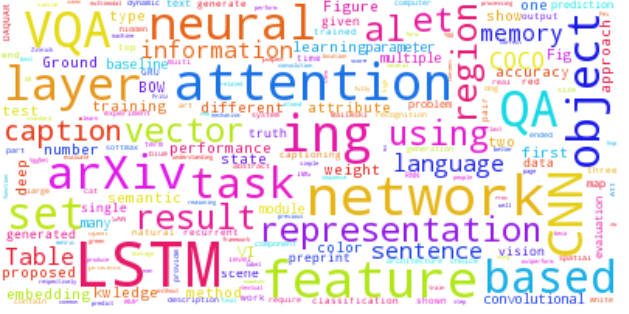List of papers
- [01VQA] VQA: Visual Question Answering
- [02EMD] Exploring Models and Data for Image Question Answering
- [03LAQ] Learning to Answer Questions From Image Using Convolutional Neural Network
- [04DCQ] Deep Compositional Question Answering with Neural Module Networks
- [05ABC] An attention based convolutional neural network for visual question answering
- [06ATM] Are you talking to a machine? datasetand methods for multilingual image question answering
- [07DPP] Image question answering using convolutional neural networkwith dynamic parameter prediction
- [08WTL] Where to look: Focus regions for visual question answering
- [09AMA] Ask me anything: Free-form visual question answering based on knowledge from external sources
- [10V7W] Visual7W: Grounded Question Answering in Images
- [11AAA] Ask, Attend and Answer: Exploring question-guided spatial attention for visual question answering
- [12SAN] Stacked attention networks for image questionanswering
- [13BOW] Simple Baseline for Visual Question Answering
- [14ICV] Image Captioning & Visual Question Answering Based on Attributes & External Knowledge
- [15DMN] Dynamic Memory Networks for Visual and Textual Question Answering
- [16CMV] Compositional Memory for Visual Question Answering
- [17LCN] Learning to Compose Neural Networks for Question Answering
Results
VQA Dataset
(as self-published by authors- not verified)
Results below are for testdev-2015, except the final column which is for test-standard
| Method | All | Y/N | Other | Num | Test-Std[All] |
|---|---|---|---|---|---|
| ~~~~~~~~~~~~~~ | ~~~~~~~~~~~~~ | ~~~~~~~~~~~~ | ~~~~~~~~~ | ~~~~~~~~~~ | ~~~~~~~~ |
| Image | 28.1 | 64.0 | 3.8 | 0.4 | - |
| Question | 48.1 | 75.7 | 27.1 | 36.7 | - |
| Q+I | 52.6 | 75.6 | 37.4 | 33.7 | - |
| LSTM Q+I | 53.7 | 78.9 | 36.4 | 35.2 | 54.1 |
| [16CMV] | 52.6 | 78.3 | 35.9 | 34.4 | - |
| [09AMA] | 55.7 | 79.2 | 40.1 | 36.1 | 56.0 |
| [13BOW] | 55.7 | 76.5 | 42.6 | 35.0 | 55.9 |
| [07DPP] | 57.2 | 80.7 | 41.7 | 37.2 | 57.4 |
| [17LCN] | 57.9 | 80.5 | 43.1 | 37.4 | 58.0 |
| [15AAA] | 57.9 | 80.8 | 43.2 | 37.3 | 58.2 |
| [12SAN] | 58.7 | 79.3 | 46.1 | 36.6 | 58.9 |
| [15DMN] | 60.3 | 80.5 | 48.3 | 36.8 | 60.4 |
WordCloud
- To get a quick sense of where most of the models are headed in terms of architecture, it suffices to see the word cloud (after removing stop-words)

Image Features
GoogleNet vs VGGNet
- Googlenet
- [16CMV]
- [13BOW]
- [14ICV]
- [06ATM]
- [11AAA]
- [12SAN]
- VGGNet
- [12SAN]
- [06ATM]
- [01VQA]
- [14ICV]
- [04DCQ]
- [09AMA]
- Some over lap is because they experimented with both the kind of features
- Some of them experimented with Alexnet, e.g [06ATM], [16CMV], [09AMA] but for all of them it was underforming model
- No one yet is using ResNet, yet.
Memory
LSTM vs GRU
- Only [15DMN] and [07DPP] are using GRU whereas others are using LSTM.
- However, it should be noted that [15DMN] uses bi-directional GRU whereas [07DPP] uses single directional GRU.
No bidirectinal LSTM
- While several of them have reported either [02EMD]’s numbers on Bi-directional LSTM (model 2-VIS+BLSTM), no one has used bi-directional LSTM in their main model.
Attention models vs non-attention models
- Following papers use Attention Models
- [15DMN] - Attention gates using modified GRUs
- [04CDQ]
- [11AAA] - Spatial attention with two hop model
- [05ABC]
- [12SAN]
- [10V7W]
- Following papers do not use any attention models, but believe that using attention would improve their model’s performance
- [07DPP]
- [02EMD]
- [06ATM]
Episodic memory vs Semantic memory
- [16CMV] claims to have used “declarative memory” which is combination of both semantic and episodic memory.
- [15DMN] uses episodic memory modules explicitly.
- For reference: Tulving, Endel. “Episodic and semantic memory 1.” Organization of Memory. London: Academic 381.4 (1972).
Activation functions used
- Sigmoid
- [15DMN] - Also uses ReLU & TanH
- [06ATM] - Also uses TanH
- ReLU
- [11AAA]
- [03LAQ]
- [04DCQ]
- [08WTL]
- TanH
- [12SAN]
- [14ICV]
- [10V7W]
- [01VQA]
- [05ABC]
- [16CMV]
Use of Batch Normalization
- Only [07DPP] and [08WTL] have used batch-normalization for their training, even though most of the other deep learning research fields have extensively used the process.
- For reference: Ioffe, Sergey, and Christian Szegedy. “Batch normalization: Accelerating deep network training by reducing internal covariate shift.” arXiv preprint arXiv:1502.03167 (2015).